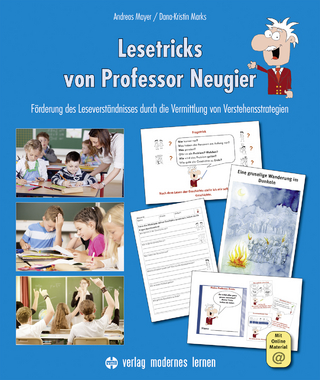
Developmental Reading and Academic Strategies for Academic Success in Secondary and Higher Education
Kendall/Hunt Publishing Co ,U.S. (Verlag)
978-1-7924-3948-3 (ISBN)
- Titel nicht im Sortiment
- Artikel merken
PrefaceChapter 1 Academic Organization
A. Section One – Choosing a Planner
B. Section Two – Multi-Tasking
C. Section Three – Organizing Multiple Classes
D. Section Four – Grouping Academic Work
E. Section Five – Organizational Resources on Campus
F. Section Six – Organizing Work for Online Courses—Getting to Know the Learning Management System and its Resources
G. Section 7 – Organizing Activities
H. Section 8 – Exploring Organizing Scenarios
I. Section 9 – Suggestions for Teaching Organization in an Online CourseChapter 2 External and Internal Barriers to Academic Success
A. Section One – External Barriers
B. Section Two – Internal Barriers
C. Section Three – External and Internal Barriers—Exercises
D. Section Four – Exploring Internal and External Barrier Scenarios
E. Section Five – Teaching About Internal and External Barriers in an Online CourseChapter 3 Who Are You as a Learner? The Four Learning Styles
A. Section One – Why is it Important to Know Your Learning Style?
B. Section Two – Learning Styles
C. Section Three – VARK Questionnaire
D. Section Four – What is a Multimodal Learner?
E. Section Five – Exercises/Assignments/Group Activities for Each Type of Learner
F. Section Six – Real-life Scenarios for Each Type of Learner to Discuss Application of Learning Strategies in their Style
G. Section Seven – Suggestions for Teaching About Learning Styles in an Online CourseChapter 4 Reading Strategies
A. Section One – Effective Highlighting (First Reading)
B. Section Two – Annotating—Margin Notes Strategy (Second Reading)
C. Section Three – Highlighting and Note-Taking Exercises
D. Section Four – Highlighting and Note-Taking Scenarios
E. Section Five – Highlighting and Note-Taking Assignments for Online CoursesChapter 5 Identifying Important Ideas
A. Section One – Five Types of Content
B. Section Two – Implied Main Idea
C. Section Three – Understanding Your Notes and Creating an Outline
D. Section Four – Creating a Summary
E. Section Five – Identifying Important Ideas—Exercises
F. Section Six – Identifying Important Ideas—Real-Life Scenarios
G. Section Seven – Identifying Important Ideas—Online Course ExercisesChapter 6 Identifying Writing Patterns and Transitions—Part I
A. Section One – Narration Writing Pattern
B. Section Two – Cause and Effect Pattern
C. Section Three – Process Pattern
D. Section Four – Comparison Writing Pattern
E. Section Five – Contrast Writing PatternChapter 7 Identifying Writing Patterns and Transitions—Part II
A. Section One – Argument/Persuasion Pattern
B. Section Two – Problem/Solution Writing Pattern
C. Section Three – Classification Writing Pattern
D. Section Four – Definition Writing PatternChapter 8 Finding the Meaning in Visual Content
A. Section One – Venn Diagram
B. Section Two – Graphs
C. Section Three – Charts
D. Section Four – Tables
E. Section Five – Photographs
F. Section Six – Geographical Maps
G. Section Seven – Film or Video
H. Section Eight – Paintings and Drawings
I. Section Nine – Visual Content ExercisesChapter 9 Test-Taking Strategies
A. Section One – General Guidelines for Tests
B. Section Two – Multiple-Choice Test Strategies
C. Section Three – Essay Test Strategies
D. Section Four – Open-Book Test Strategies
E. Section Five – Test Strategy Exercises
F. Section Six – Test Strategy ScenarioChapter 10 Textbook Design
A. Section One – Identifying Common Textbook Features
B. Section Two – Additional Features
C. Section Three – Textbook Design ExerciseChapter 11 Identifying Tone, Bias, and Logical Fallacies
A. Section One – Connotative Language and Tone
B. Section Two – Understanding Bias
C. Section Three – Identifying False Arguments (Logical Fallacies)
D. Section Four – Tone, Bias, and Logical Fallacies—ExercisesChapter 12 Reading Strategies for the Research Process
A. Section One – Finding Sources
B. Section Two – Research Note-Taking
C. Section Three – Research Note-Taking Tools
D. Section Four – Reading Strategies for the Research Process—Exercises
| Erscheint lt. Verlag | 30.1.2021 |
|---|---|
| Verlagsort | Iowa |
| Sprache | englisch |
| Themenwelt | Geisteswissenschaften ► Sprach- / Literaturwissenschaft ► Sprachwissenschaft |
| Sozialwissenschaften ► Pädagogik ► Erwachsenenbildung | |
| Sozialwissenschaften ► Pädagogik ► Schulpädagogik / Sekundarstufe I+II | |
| ISBN-10 | 1-7924-3948-2 / 1792439482 |
| ISBN-13 | 978-1-7924-3948-3 / 9781792439483 |
| Zustand | Neuware |
| Haben Sie eine Frage zum Produkt? |
aus dem Bereich
